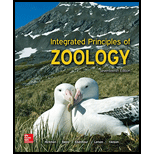
Concept explainers
Explain the significance of the discovery of Archaeopteryx. Why did this fossil demonstrate beyond reasonable doubt that birds are grouped phylogenetically with dinosaurs?
To describe: The significance of the discovery of Archaeopteryx.
Introduction: Archaeopteryx refers to the genus of bird-like dinosaurs, which lived in the Late Jurassic around 150 million years ago. It had a size of about one foot and eight inches.
Explanation of Solution
Archaeopteryx fossil was discovered by the workman in the year 1861. Its fossil was a fortunate discovery as the fossil records of birds were meager. It also serves as the fossil proof for demonstrating the phylogenetic relationships between the birds and the extinct theropod dinosaurs.
To explain: The reason due to which the fossil of Archaeopteryx demonstrated beyond reasonable doubt for the phylogenetic grouping of birds with dinosaurs.
Introduction: The term phylogeny refers to the evolution of a species in the context of its ancestry and its evolutionary relationship with other organisms. Archaeopteryx is considered as the connecting link which explains the phylogenetic relation between birds and dinosaurs. Currently, birds are considered to be a group of theropod dinosaurs which originated in the Mesozoic Era.
Explanation of Solution
The size of the fossil of Archaeopteryx was approximately of the size of a crow. It had a skull which was not similar to that of the modern birds and a beak-like jaw which bore small bony teeth set in sockets, like those observed in dinosaurs. Its skeleton was reptilian with a long bony tail, clawed fingers and abdominal ribs and its body also carried the imprint of feathers.
These features observed in the fossil of Archaeopteryx, demonstrate the phylogenetic relation between birds and dinosaurs.
Want to see more full solutions like this?
Chapter 27 Solutions
LooseLeaf for Integrated Principles of Zoology
- please fill in the empty sports, thank you!arrow_forwardIn one paragraph show how atoms and they're structure are related to the structure of dna and proteins. Talk about what atoms are. what they're made of, why chemical bonding is important to DNA?arrow_forwardWhat are the structure and properties of atoms and chemical bonds (especially how they relate to DNA and proteins).arrow_forward
- The Sentinel Cell: Nature’s Answer to Cancer?arrow_forwardMolecular Biology Question You are working to characterize a novel protein in mice. Analysis shows that high levels of the primary transcript that codes for this protein are found in tissue from the brain, muscle, liver, and pancreas. However, an antibody that recognizes the C-terminal portion of the protein indicates that the protein is present in brain, muscle, and liver, but not in the pancreas. What is the most likely explanation for this result?arrow_forwardMolecular Biology Explain/discuss how “slow stop” and “quick/fast stop” mutants wereused to identify different protein involved in DNA replication in E. coli.arrow_forward
- Molecular Biology Question A gene that codes for a protein was removed from a eukaryotic cell and inserted into a prokaryotic cell. Although the gene was successfully transcribed and translated, it produced a different protein than it produced in the eukaryotic cell. What is the most likely explanation?arrow_forwardMolecular Biology LIST three characteristics of origins of replicationarrow_forwardMolecular Biology Question Please help. Thank you For E coli DNA polymerase III, give the structure and function of the b-clamp sub-complex. Describe how the structure of this sub-complex is important for it’s function.arrow_forward
 Human Biology (MindTap Course List)BiologyISBN:9781305112100Author:Cecie Starr, Beverly McMillanPublisher:Cengage Learning
Human Biology (MindTap Course List)BiologyISBN:9781305112100Author:Cecie Starr, Beverly McMillanPublisher:Cengage Learning Biology: The Dynamic Science (MindTap Course List)BiologyISBN:9781305389892Author:Peter J. Russell, Paul E. Hertz, Beverly McMillanPublisher:Cengage Learning
Biology: The Dynamic Science (MindTap Course List)BiologyISBN:9781305389892Author:Peter J. Russell, Paul E. Hertz, Beverly McMillanPublisher:Cengage Learning Biology: The Unity and Diversity of Life (MindTap...BiologyISBN:9781305073951Author:Cecie Starr, Ralph Taggart, Christine Evers, Lisa StarrPublisher:Cengage Learning
Biology: The Unity and Diversity of Life (MindTap...BiologyISBN:9781305073951Author:Cecie Starr, Ralph Taggart, Christine Evers, Lisa StarrPublisher:Cengage Learning Biology (MindTap Course List)BiologyISBN:9781337392938Author:Eldra Solomon, Charles Martin, Diana W. Martin, Linda R. BergPublisher:Cengage Learning
Biology (MindTap Course List)BiologyISBN:9781337392938Author:Eldra Solomon, Charles Martin, Diana W. Martin, Linda R. BergPublisher:Cengage Learning
 Concepts of BiologyBiologyISBN:9781938168116Author:Samantha Fowler, Rebecca Roush, James WisePublisher:OpenStax College
Concepts of BiologyBiologyISBN:9781938168116Author:Samantha Fowler, Rebecca Roush, James WisePublisher:OpenStax College





